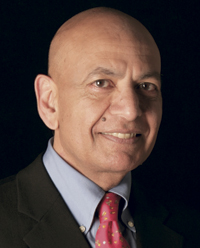 Even if China's growth slows, it still will surpass theUnited States' GDP leadership in the next 10 to 12 years, but don'texpect the same with its technology innovation, says Anil Gupta,professor at the Smith School of Business at University ofMaryland, in remarks made during a discussion about innovation andthe economy at the EuroFinance International Cash and TreasuryManagement conference in Miami, Fla. early this month.
Even if China's growth slows, it still will surpass theUnited States' GDP leadership in the next 10 to 12 years, but don'texpect the same with its technology innovation, says Anil Gupta,professor at the Smith School of Business at University ofMaryland, in remarks made during a discussion about innovation andthe economy at the EuroFinance International Cash and TreasuryManagement conference in Miami, Fla. early this month.
Gupta, aleading expert on strategy, globalization and emerging markets,says that “sometime in the next 10 to 12 years, it is certainChina's GDP as a percent of global share will overtake the U.S.[GDP]. But technologically, it will not overtake [the U.S.] for atleast two decades.”
|As evidence, Gupta notes although China now has 20% of theworld's population, 9% of global GDP and 13% of world spending onresearch and development, it holds only 1% of the world's patents.In biotech publications, only 3% of articles are by Chineseauthors, while 60% are by U.S. authors. “This is a huge gap,” hesays.
|China's involvement in new energy further points out the lapse:it has 50% of the world's investment in new energy, but only 5% ofthe patents. “China's strengths are investment and manufacturing,not innovation,” Gupta told the audience of corporate financeexecutives in Miami.
|Most finance executives polled at the meeting believe China'sgrowth will slow. Gupta agrees, noting that in the past 30 years,China saw average annual growth of 10%, while this decade it willgrow between 6% and 7%. The reasons include strains in the laborforce, capital investment and total factor productivity (TFP). Henotes that China's one-child policy has finally caught up with it,so the labor pool will shrink. Capital investment also will slow,while TFP has peaked, Gupta says, noting for example autopurchasing. He sees the market penetration in autos already has hita near-term high, which appears to be the case for housing aswell.
|Gupta also argues that in the next five years, China could see arevolution—possibly violent—if political reforms don't happenfaster. “At the very top of the leadership of China, there areserious ideological conflicts…reformers vs. conservatives,” hesays. “Reformers want economic and political reform.”
|Political reform means moving toward a freer society, whileeconomic reform means reducing the number of state-ownedindustries. “It seems very clear the reformers are gaining,” Guptasays, citing the recent release of Chinese dissident ChenGuangcheng. Both rural and urban populations are increasinglyunwilling to put up with the current political situation, he says,and high literacy rates and access to technology, as well as beingbetter off economically, allow people to be more assertive. Andmost likely the renminbi will become convertible in next five to 10years, allowing Shanghai to become a true global financial center,a key goal of the Chinese government.
|With Chinese growth slowing, although it remains high comparedto mature economies, and the potential for a volatile politicalsituation, should U.S. companies still expand into China? Inconsumer goods, “China already is an open market, and state-ownedcompanies don't play a role,” he says. But when it comes toindustries that largely are state-controlled, like steel productionor banking, expansion into China is still a question mark.
Complete your profile to continue reading and get FREE access to Treasury & Risk, part of your ALM digital membership.
Your access to unlimited Treasury & Risk content isn’t changing.
Once you are an ALM digital member, you’ll receive:
- Critical Treasury & Risk information including in-depth analysis of treasury and finance best practices, case studies with corporate innovators, informative newsletters, educational webcasts and videos, and resources from industry leaders.
- Exclusive discounts on ALM and Treasury & Risk events.
- Access to other award-winning ALM websites including PropertyCasualty360.com and Law.com.
*May exclude premium content
Already have an account? Sign In
© 2024 ALM Global, LLC, All Rights Reserved. Request academic re-use from www.copyright.com. All other uses, submit a request to [email protected]. For more information visit Asset & Logo Licensing.







